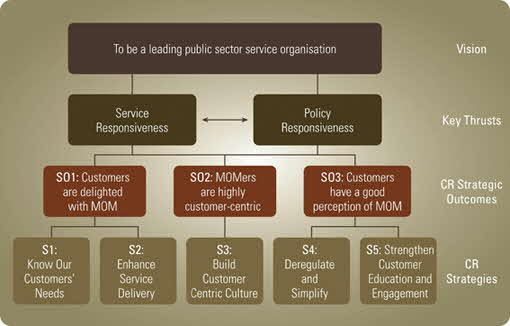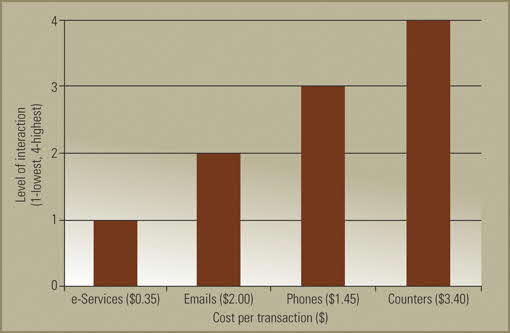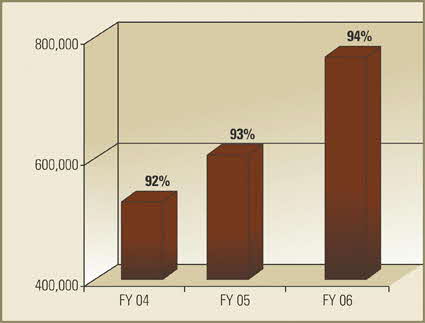Better, Faster, Cheaper: Service Transformation and Channel Migration at the Ministry of Manpower
ETHOS Issue 02, Apr 2007

Public agencies around the world are under increasing pressure to do more with less. More and more are being caught in a “value squeeze”,1 seeking more efficient ways to create public outcomes amidst calls for better, faster service against tighter budgets and rising customer expectations.
The Ministry of Manpower (MOM) faces similar pressures. It has responded by aligning its service excellence goals to the broader MOM vision of creating a Great Workforce and a Great Workplace.
In June 2003, the Customer Responsiveness Department was created within MOM to establish a dedicated capability for strategic leadership and to drive the planning and delivery of all MOM services and customer responsiveness initiatives.
A Customer Responsiveness Framework (Figure 1) sets out the strategic outcomes and key strategies for MOM’s service vision. While MOM’s core functions often have a highly regulatory component aligned with Singapore’s manpower policies, the Framework defines a customer-centric service delivery approach that emphasises trust, superior communications and a positive customer experience through high quality service delivery.
FIGURE 1. CUSTOMER RESPONSIVENESS FRAMEWORK

DIVERSE CUSTOMER BASE, MULTI-CHANNEL SERVICES
MOM serves a wide spectrum of customers in two principal groups: employers (comprising both about 100,000 businesses as well as individual employers of foreign domestic workers) and employees (comprising about 1.8 million locals and about 900,000 foreigners on a variety of work passes).
Employer types range from families hiring foreign domestic workers in households, to small one-man operated businesses, to global multinational corporations. Workers comprise both local and foreign employees of varying levels of skills and educational levels.
In order to meet the needs of this diverse profile of customers, MOM maintains a multi-channel service delivery strategy.
Each year, MOM:
- receives about 1.6 million e-transactions;
- assists about 72,000 e-transactions through the e-Service Lobby;
- handles about 2 million calls to the MOM Contact Centre;
- replies to about 130,000 emails;
- receives about 36 million website visits; and
- receives about 760,000 counter visits.
This is achieved with a frontline force of about 150 officers (including outsourced centres).
Due to MOM’s high volume of transactions, its website and other electronic channels are configured as ideal first points of contact and self-help service modes. Electronic platforms provide customers with speed, convenience and accessibility from anywhere in the world. Furthermore, cost comparisons across various channels show that electronic channels are the most cost-effective (Figure 2).
FIGURE 2. COST COMPARISONS

CHANNEL MIGRATION: MAKING ELECTRONIC SERVICES THE FIRST AND BEST CHOICE
Website revamp: The MOM website was revamped in October 2006, taking into account feedback from a representative sample of 4,000 customers. It was reorganised into several main categories (by customer groups, and by the most frequently visited functional areas which are work passes, workplace relations, and workplace safety and health). Transactional services were also made more user-friendly, and interactive tools such as e-calculators, self-assessment tools, e-guides, e-tutorials and e-demos were introduced to facilitate self-help and self-learning.
E-services palette, differential service: A whole suite of e-services is provided to MOM customers, from the processing of work passes, to the reporting of workplace accidents, and services relating to employer-employee relations. One important e-service is the Work Permit Online (WPOL) system, which offers employers a world-class system for processing work permits (see box story on "Work Permit Online: A World Class E-Service"). Employment information such as foreign worker quota eligibility, levy and application outcomes have also been made easily accessible online.
MOM offers differential pricing and superior service standards for online channels for two of its key services, viz. WPOL and Employment Pass Online (EPOL) services. A work permit submitted online is processed by the next working day, compared to one week for manual applications. For employment passes, online applications take one week, compared to three weeks for manual submissions. For both work permits and employment passes, fees are waived for online renewals and issuing of passes, whereas there is an administrative fee of $20 for each counter transaction.
Contact Centre—emails and calls: MOM’s contact centre is outsourced to external vendors who are given incentives to reduce call enquiries and convert customers to using electronic service channels. Call trends are also closely monitored for opportunities to migrate customers to self-help channels. For instance, the top five call types were found to be on work permit application procedures, work permit renewal procedures, levy, work permit rejection reasons and error messages encountered from the WPOL service. The website was then revised to provide a step-by-step guide of work pass application and renewal procedures, as well as an e-demo on work pass application procedures. The interactive Foreign Worker Levy Billing (iFWLB) service was enhanced, allowing customers to check outstanding levy amounts and make online payments. The content in the WPOL system and MOM website were reviewed and simplified to be more user-friendly. In addition, the WPOL service was enhanced to enable employers to view work permit rejection reasons online. The overall result has been a migration of 25% of work permit callers from the contact centre to online channels.
Assuring usability: A key learning point from the development of the WPOL system is the need to build in usability tests at the outset of system design. MOM now requires that usability testing by actual customers take place on prototypes of major e-services before implementation. Feedback is then taken into consideration and design aspects tweaked before actual rollout. During the pilot phase following prototyping, design changes are tested out with small groups of pilot users and refinements made before the actual launch, to ensure that the final system is truly user-friendly to customers under real-world conditions.
Customer education and engagement: MOM actively engages and educates its partners and customers, including employment agents, who are the main intermediaries for the employers of foreign domestic workers and smaller businesses. Hands-on training, individualised coaching and regular briefings on the WPOL e-service are still conducted today. Users are also kept updated regularly via email and internet broadcasts to account holders.
These efforts to make online channels the best and most frequently used service channel have paid off with utilisation of the WPOL service climbing from 85% in 2005, to 95% in 2006, to 98% today.
The Work Permit Online service (WPOL) is today a leading-edge e-service for Singapore businesses with a processing capacity, integrative features and efficiency standards that are unsurpassed in the world.
In order to achieve dramatic improvements in transaction time, over 50 rules, procedures and requirements were reviewed in the development process, and back-end integration between agencies was exploited where possible.
WORK PERMIT ONLINE: A WORLD CLASS E-SERVICE
The Work Permit Online service (WPOL) is today a leading-edge e-service for Singapore businesses with a processing capacity, integrative features and efficiency standards that are unsurpassed in the world.
In order to achieve dramatic improvements in transaction time, over 50 rules, procedures and requirements were reviewed in the development process, and back-end integration between agencies was exploited where possible.
The resulting system improvements have led to faster processing times despite record transaction volumes and with no increase in staffing levels. Employers using WPOL enjoy processing standards that are the best in the world:
- 90% of service requests processed either immediately or by the next working day;
- Renewals are processed within one day, cancellations within 15 minutes;
- Number of actual trips to MOM reduced from four to one; and
- Number of documents to be submitted reduced from 23 to seven.
WORK PASS APPLICATIONS RECEIVED AND PERCENTAGE PROCESSED WITHIN BENCHMARK TIME

For its achievements, the WPOL service was awarded the 2006 UN Public Service Award for improving transparency, accountability, and responsiveness in the Public Service. MOM was one of only three government organisations worldwide, and the only one in the Asia-Pacific region to receive the award. – Penny Han
TOWARDS HIGHER SERVICE QUALITY
MOM’s customer responsiveness approach has borne fruit. Customer perception survey results have shown steady improvements over the years, with the percentage of satisfied customers increasing from 91.2% in 2006 to 93.2% in 2007. MOM scored well in the annual Pro-Enterprise Ranking (PER) survey amongst businesses, rising from a PER index of 72.5 in 2006 to 74.6 in 2007. In recognition of the management systems and processes in place for service excellence, MOM was also awarded the Singapore Service Class certification in November 2007.
MOM plans to deliver more electronic and mobile services in the near future. The Employment Pass (EP) Online service will be enhanced, like the successful WPOL, to significantly improve turnaround times for EP processing. Another key e-service will be the development of an integrated Occupational Safety and Health service that will bring together services for reporting workplace accidents, applying for licences and obtaining advice relating to workplace safety and health issues.
Higher customer expectations from a more educated populace will continue to generate demand for even more sophisticated levels of service delivery. At MOM, the next phase of customer responsiveness is to move beyond efficiency targets to raising the standards of service quality. Policies and service strategies will be kept responsive. Quality assurance across all business departments will be ramped up. To intensify customer engagement and outreach, MOM will do more to ensure closure of feedback loops in handling policy and customer-related issues. In 2008, a “Best Public Suggestion Award” will recognise members of the public who have provided suggestions that have led to significant service improvements for the Ministry—this will enhance customer engagement and encourage good suggestions from the public to improve services.
MOM has seen the fruits of its early efforts at service transformation. It has worked hard to balance an effective multi-channel strategy that is sensitive to its customers’ diverse needs with the broader drive towards cost-effectiveness and value creation. It is a clear illustration that a policy-oriented, regulatory agency can deliver a superior customer experience and responsive service vision that is on par with the best in the world.
While customers are encouraged to self-help as far as possible, the less educated, less Internet-savvy or simply those who need help with situational enquiries are still able to get personalised assistance from a variety of service delivery channels, including:
PERSONALISED ASSISTANCE: THERE WHEN NEEDED
While customers are encouraged to self-help as far as possible, the less educated, less Internet-savvy or simply those who need help with situational enquiries are still able to get personalised assistance from a variety of service delivery channels, including:
- Phone: The MOM Call Centre aims to be efficient, accurate and reliable. The Contact Centre, which is outsourced, answers 4,000 to 5,000 calls daily within one minute, 80% of the time.2 No more than 10% of calls are dropped by customers waiting to have their enquiries addressed. Those who need case-specific assistance are put in touch with domain specialists, where enquiries are responded to within one working day for 95% of cases.
- Email: Email responses are given in a timely manner, with general enquiries responded to within one working day for 95% of all enquiries received. Customers are also able to receive comprehensive responses to queries sent through an e-feedback service on the website.
- Counters: Counter services, which offer efficient service and expert advice for specific cases, are maintained for advisory and transactional services which cannot be performed through online channels.
NOTES
- Cole, Michael and Parston, Greg. Unlocking Public Value: A New Model for Achieving High Performance in Public Service Organizations. New Jersey: John Wiley & Sons, Inc. 2006: pp.xiii.
- From October 2008, this will be enhanced to 80% of calls answered within half a minute.
NOTES
- Department of Statistics, Key Household Income Trends (Singapore: Ministry of Trade and Industry, 2006).
- The Economist noted that since 2000, real wages for the median US worker rose only about 1.5% even after accounting for health and pension benefits, even though productivity grew by as much as 15%.
- Lindert, Peter H., Growing Public: Social Spending and Economic Growth since the Eighteenth Century (UK: Cambridge University Press, 2004).

